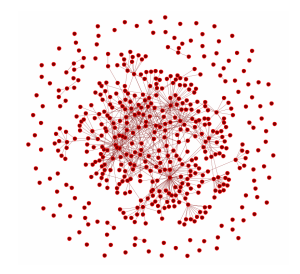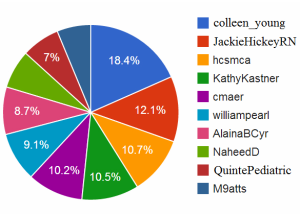#hcsmca – A Social Network Analysis of our Community
Back in Nov-Dec 2012 social scientists Anatoliy Gruzd, PhD and Caroline Haythornthwaite, PhD, did a social network analysis of #hcsmca. The results were recently published in the Journal Medical of Internet Research – Enabling Community Through Social Media*.
This week Feb. 5, @gruzd (Dalhousie University) and @hthwaite (University of British Columbia) will be our special guests on #hcsmca. They will discuss the findings of their analysis, which I hope will lead to an animated conversation as we explore a reflection of ourselves. Here is the Feb 5th #hcsmca transcript.
In their study of #hcsmca, the authors asked:
-
What accounts for the relative longevity of this particular online community? Is it because of the founder’s leadership and continuing involvement, or are there core members who are actively and persistently involved in this community?
-
What is the composition of this community in general? And, more specifically, does their professional role determine a person’s centrality within this community? This allowed the authors “to understand generally how professional roles affect online conversational dynamics, and more specifically whether this online community is a welcoming place for a wide range of professionals or is, instead, dominated by professionals from a particular group.”*
Here’s a selection of some the findings that were of particular significance to me as the Founder and Community Manager of #hcsmca. (Quotes from the JMIR paper.*)
“Results from the network analysis reveal a cohesive group.”
The network visualization of the #hcsmca shows a “fairly densely connected, single component of posters who are reading and responding to each others’ posts, suggesting an engaged community, paying attention to the topic and actively conversing around the common topic.”
“Noticeably absent from [the visualization] are subcliques that carry on side conversations with each other. This shows that the #hcsmca community is not fractionated, but rather that participants are all engaged with the single conversational network.”
Not surprisingly, as the community organizer, I post the most messages. But there are other “active participants who contribute heavily to the community, posting about the same number of messages each (approximately 10% of the messages posted by the top 10 posters all together). Such actors also contribute to the critical mass of the conversation, but the more important result is that there are several people the community can rely on to keep the conversation going, increasing the robustness of the ongoing activity.”
The authors also found “no apparent preferential attachment among people in the same professional group. In other words, the formation of connections among community members is not necessarily constrained by their professional status. This result indicates connections are more prevalent across members with different professional backgrounds and occupations in this community, which in turn may suggest that this is a welcoming environment that stimulates knowledge exchange and learning across professional boundaries.”
Join the conversation on February 5 at 1pm ET to find out more about:
- How we connect
- What this analysis tell us about us
What would you like to ask Anatoliy and Caroline?
Reference *Gruzd A, Haythornthwaite C, Enabling Community Through Social Media, J Med Internet Res 2013;15(10):e248 URL: http://www.jmir.org/2013/10/e248/ doi: 10.2196/jmir.2796 PMID: 24176835. - Graphics reproduced with permission from authors.



Colleen it is fascinating to read this research. I am particularly interested in the point about sub-conversations. I have noticed this happening in some other chats, and I have a theory on why this may be. If the chat moves too fast, sometimes “side chats” happen alongside the main discussion. I see this as a way of getting some control over a chat that is moving too fast for considered discussion and full inclusion of all chat participants. When a chat moves at a slower, more manageable pace I don’t see this happening so much.
LikeLike
This is a common phenonemon in communities that have become (too) large. There is an optimal size for every community. Once a community surpasses its optimal size, then a couple things happen. The overall sense of community starts to erode as people feel they are less able to influence or be influenced by the community. Often splinter groups form and if a leader emerges, then a splinter can develop into its own successful community.
In the case of a community managed by an astute community manager, the splinter groups will be identified as they form and encouraged to flourish before the sense of community deteriorates and threatens the sustainability of the community. Relevant and manageable data collected regularly and consistently can help community managers read the trends of the community and guide it as dictated by the community.
Analysis such the work by Caroline and Anatoliy are invaluable for diving deeper and evaluating a community.
LikeLike
Yes, that makes perfect sense and once again points to the fact that for the uninitiated chats appear to be more straightforward than they are. Being an effective moderator requires some key community management skills.
LikeLike
Reblogged this on Health Care Social Media Monitor and commented:
I am always fascinated to read the social science research. This is a very interesting study on #HCSMCA the healthcare social media chat for Canada.
LikeLike
Is there something you will do differently as a result of this analysis?
LikeLike
Joitske, That is a very good question. Much of the analysis confirmed that we were meeting our goals. Success for #hcsmca was defined as engaging a cohesive community of practice where the import is placed on the message not necessarily a person’s affiliation. The analysis shows that we are doing that. But it also pointed out that certain groups of people were either under-represented or absent in our conversations. Concerted efforts were made and continue to be made to include these groups.
What other opportunities do you see from the analysis?
LikeLike
Fascinating study, many thanks Anatoliy and Caroline – and to Colleen as the Mother of #hcsmca.
For me being both ‘in- and out-degree’ is gratifying, considering my own evolution in the space – starting with #hcsm (where I virtually met Colleen :) and then following sub groups took flight and caught my interest.
As sub groups continue to emerge, I’ve observing the coming-together/splitting-off/coming-together of large communities of interest, into more focused.
I’ve become part of the ‘end of life’ communities: which started with hospice and palliative medicine #hpm which then hatched more specific end of life chats: End of Life (#EOLchat) Death with Dignity (#DWDchat) #Caregiving #Eldercarechat. Thus, when #hcsmca topics were relevant to end of life – I could – and would – bring ‘my’ various communities together – each with a different point of view. How sweet that bringing like-minded together, has made an impact (at least in this study!)
Mostly, tho, it’s the power of twitter: facilitating specific and collective brainpower and passions. #W00t!
LikeLike
Many thanks for posting this Colleen.
I would really like to understand the network visualization figure more. Would you be willing to share a version of that diagram with your own annotations/labels, so that we can be sure we all have the same interpretation? For example, do the lines represent individual posts/messages or extant connections between two people by virtue of ‘one-time’ messages? That would be really helpful if you would summarize how you interpret that diagram.
Many thanks in advance!
LikeLike
Hi Tim,
For the authors’ interpretation of the visualization figure, see the original journal article http://www.jmir.org/2013/10/e248/.
What might also be interesting is a second blog post of how I as a community manager interpret these findings. Stay tuned.
Colleen
LikeLike